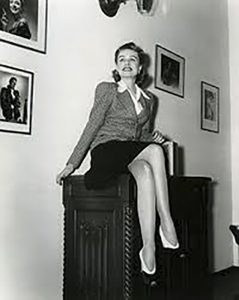Wendy Reves: From Marshall to Fame
by admin | March 15, 2019 8:38 am
The woman who became internationally known as Wendy Reves started out as Wyn-Nellie Russell, a native of Marshall, Texas. Born in 1916, she fled there at 17. She later claimed she saw a black man tarred and feathered there by the Ku Klux Klan as a child and apparently never returned to Marshall. An early marriage failed but got her out of East Texas in the early 1930s.
She was a slender, long-legged beauty who became a top model for the Powers Agency after moving to New York and renaming herself Wendy. Photos of her soon appeared in Harper’s Bazaar and Vogue. Not long after her modeling career began, she marrie d Paul Baron, a well-known band conductor. That marriage didn’t last either, and after a period of years dating movie stars such as Cary Grant and Errol Flynn, she met Emory Reves, a dozen years her senior, when the Hungarian-born writer and publisher visited New York.
d Paul Baron, a well-known band conductor. That marriage didn’t last either, and after a period of years dating movie stars such as Cary Grant and Errol Flynn, she met Emory Reves, a dozen years her senior, when the Hungarian-born writer and publisher visited New York.
Reves founded the Cooperation Publishing Service in 1933 and became Winston Churchill’s literary agent four years later. When Churchill became prime minister in 1940, he sent Reves to America to build Britain’s case for America joining in the fight against Nazi Germany. After World War II ended, Reves became Churchill’s publisher outside the United Kingdom, publishing both his memoirs and History of the English-Speaking Peoples. Reves sold the rights to Churchill’s The Second World War for $1.4 million in the United States and 555,000 pounds in the UK — more than $32 million in today’s money, according to Churchill biographer Andrew Roberts. In addition, Reves wrote and published The Anatomy of Peace, which dissected the causes of World War II and became a global bestseller in the aftermath of that war. Reves was nominated for the Nobel Peace Prize in 1950.
Reves was immediately smitten with Wendy. But as she told D Magazine in 1991, for her it was not exactly love at first sight. Eventually they became a couple. Emory — who had begun collecting art after World War II — in 1953 purchased Villa La Pausa, a massive compound in the south of France, from Coco Chanel, whose lover, the Duke of Westminster had it built. Emory and Wendy lived and entertained there, continually adding to the art collection. Churchill was a frequent visitor, according to Roberts. Churchill’s wife, Clementine, disapproved. She called the Reves’ relationship “that unconventional and uneasy ménage,” because the couple didn’t marry until 1964 — and only then to ensure Wendy could inherit upon Emory’s death.
Roberts recounts another time, when the wife of a Churchill cousin made a disparaging remark about Wendy. The aging statesman growled, “Daisy, Wendy is three things you will never be. She is young, she is beautiful and she is kind.” Churchill continued to visit, often setting up his easel and painting landscapes.
Reves died in 1981, and Wendy continued to live at La Pausa. She eventually donated more than 1,400 works to the Dallas Museum of Art, which in 1985 opened a 16,500-square foot wing that recreated five rooms from La Pausa. Paintings by Paul Cézanne, Vincent van Gogh, Claude Monet and many others hang in the same places in which they hung in France. Wendy died in 2007 at 90.
It is a compelling collection, providing a rare glimpse into life among the wealthy in post-war Europe. My Beautiful Mystery Companion and I visited it recently, marveling at the ornate furnishings and the priceless art. Especially compelling were the letters and other effects of Churchill. (We’re in the midst of reading Roberts’ magnificent biography, Churchill: Walking With Destiny.) There is a photograph of Churchill sitting in his favorite 17-century chair in the Reves’ study, which is filled with books and artwork. Several of Churchill’s paintings are on display, revealing him as a talented amateur artist. Churchill had a habit of balancing his ever-present cigar on a brandy glass, so Wendy had made a custom-made silver cigar holder, inscribed, “Welcome to Pausa Land.” That was Churchill’s nickname for the villa.
The Reves exhibit is worth the trip to Dallas by itself, but DMA has a number of fine exhibits — including Henry Clay’s 13-foot high canopy bed. The 19th-century statesman had it custom built and planned to have it installed in the White House when he won the presidency. That never occurred, of course, though Clay tried three times.
When the Marshall newspaper editor in 1987 wrote an editorial urging the city to transform, “Marshall’s square, every tree, every bush, decorated with tiny white lights” at Christmas, Reves responded by sending a $25,000 check with a note: “Have your dream.” The Wonderland of Lights has been an East Texas tradition since, thanks in part to a small-town girl who made it to the big time.
Source URL: https://garyborders.com/pages/wendy-reves-from-marshall-to-fame/